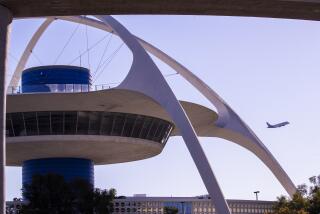Late Takeoffs Banned Over Topanga and Calabasas
- Share via
Residents of Topanga Canyon and Calabasas have won a partial victory in a five-year campaign to keep noisy jets taking off from Los Angeles International Airport from flying over their communities.
The Federal Aviation Administration said Wednesday that it has halted late-night flights over the two communities by airliners heading from LAX to Northern California.
Jetliner pilots will be prohibited from flying over the area between 9 p.m. and midnight, said FAA spokesman Fred O’Donnell. There are no commuter flights between midnight and 6 a.m.
After 9 p.m., planes taking off from LAX are being required to fly farther west over the Pacific Ocean to climb in altitude before turning north.
Dozens of Aircraft
As many as 70 jetliners a day have been flying over Topanga and Calabasas on a takeoff path known as “Gorman Five.”
The new procedures went into effect over the weekend, O’Donnell said.
The change in takeoffs represents the FAA’s first acknowledgment that jet noise is a problem for residents of the two communities at the southwestern edge of the San Fernando Valley.
Last year, FAA officials brushed aside complaints by comparing jet noise over the area with the sound of birds, dogs, cars and wind.
At the same time, the FAA removed an LAX administrator assigned to investigate noise complaints who had criticized an FAA report that concluded that “there is no appreciable difference between the aircraft noise and ambient noise for the area.”
Report Conclusions
The report stated that “ambient noise (bird/dogs/cars/wind)” registered at 65 to 80 decibels. Departing jets peaked in the 50- to 65-decibel range, the report said.
That prompted angry community leaders to seek help from Rep. Anthony C. Beilenson (D-Tarzana), who called for a formal FAA investigation into the dispute.
Barry Glaser, president of the Topanga Town Council and one of the most persistent critics of the over-the-canyon takeoffs, credited Beilenson’s intervention with prompting the ban.
“It’s fantastic, just wonderful. We’re already noticing a difference,” Glaser said. “We understand the airlines don’t like it and it was difficult to do, but we feel it’s a good first step. Congressman Beilenson has taken a good, strong position.”
The takeoff change was announced by Jeffrey Thorstenson, manager of the FAA’s air space and procedures branch.
He declined further comment Wednesday, however, and O’Donnell said he did not know how many nighttime flights were affected.
O’Donnell said he did not know if it is possible to route other Gorman Five takeoffs farther west to avoid Topanga and Calabasas.
“If we can safely reroute traffic without impeding safety, we most certainly would do that,” O’Donnell said. “Noise abatement is an important issue with the FAA. Until further notice, they will be directed to a Ventura departure.”
Hope Change Is Permanent
Opponents of the noise said Wednesday that they hope the change is permanent.
Virginia Hatfield, a field representative for Beilenson, said her office in December appealed to FAA officials in Washington for a 60-day test period to study the noise situation.
She said her office has not received official notification from the FAA of the takeoff ban.
But blissful nighttime quiet the past few days has been notification enough for such homeowners as Margaret Rawls of Calabasas.
“We can sleep now. It’s a definite improvement,” said Rawls, who has fought the jet noise since 1984.
“There weren’t that many jets flying over late at night. But those that did were enough to wake you up.”
More to Read
Sign up for Essential California
The most important California stories and recommendations in your inbox every morning.
You may occasionally receive promotional content from the Los Angeles Times.














